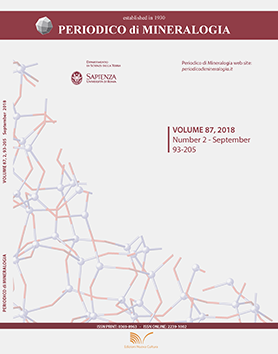Major-trace elements geochemical characterization, geochronology and radiogenic isotopesg of Eocene magmatic rocks in Anique, Qaradagh pluton, NW Iran
DOI:
https://doi.org/10.2451/2018PM789Keywords:
Qaradagh batholiths, geochemistry, Cordilleran granitoid, continental arc, Cu-Mo-Au mineralizationAbstract
The Qaradagh batholith straddles the border between Armenia and NW Iran and is a constituent of the Arasbaran Magmatic Belt (AMB). The Qaradagh batholith is composed of several distinct basic to intermediate and felsic intrusions, cross cut by various dykes.
40Ar/39Ar biotite step-heating plateau ages of 40.52 ± 0.44 Ma for a granodiorite intrusion indicate that intrusive activity is of early Eocene age. These intrusions are generally biotite, amphibole, magnetite, and titanite-bearing oxidized I-type and can be determined as magnetite series Cordilleran granitoids. They are enriched in LILE, relatively enriched in LREE, depleted in some HFS elements specially Ti, Nb, Ta (TNT) and P, and relatively depleted in HREE. They also have distinctly low Rb/Sr ratios (mainly 0.08-0.525), consistent with derivation from mantle wedge materials and limited contribution from crustal materials. The granitoids have arc-like signatures and the relatively flat HREE patterns (Sm/Yb = 1.08 - 5.29). The restricted range of initial 87Sr/86Sr (0.7043 to 0.7050) and positive εNdi values (+3.1 to +2.5) suggest depleted mantle- derived magmas were the primary source of these granitoids. Based on the chronology results, the Anique granitoids were the earliest bodies intruding the AMB which took place during the early stages of subduction evolution. These magmatic units were emplaced along the ocean-ward portion of the AMB continental arc. The major and trace element, and Sr-Nd isotope geochemistry indicates that these granitoids have mantle- dominated characteristics, which suggests accretion of new continental crust in the Early Cenozoic in this part of the northwestern Iranian Micro-Continent.
Downloads
Published
Issue
Section
License
Copyright (c) 2018 PERIODICO di MINERALOGIA

This work is licensed under a Creative Commons Attribution 4.0 International License.


